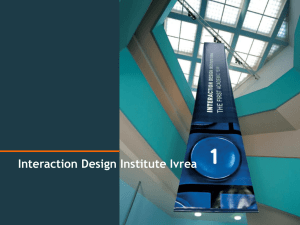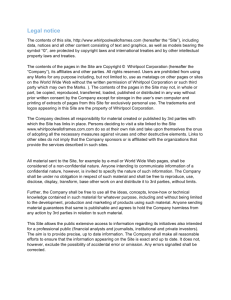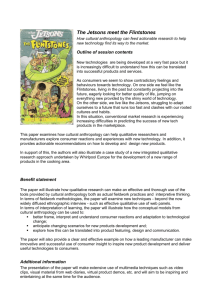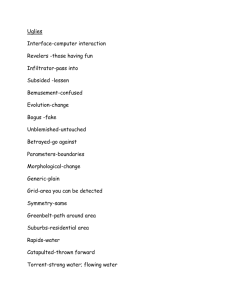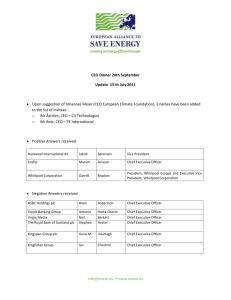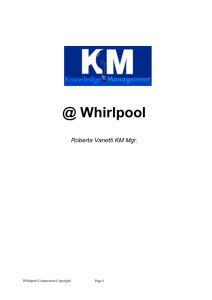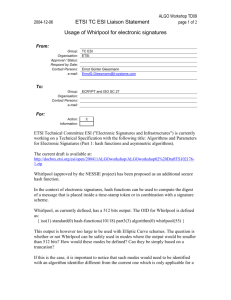DFFN_exec_summary_Wh.. - Interaction Design Institute Ivrea
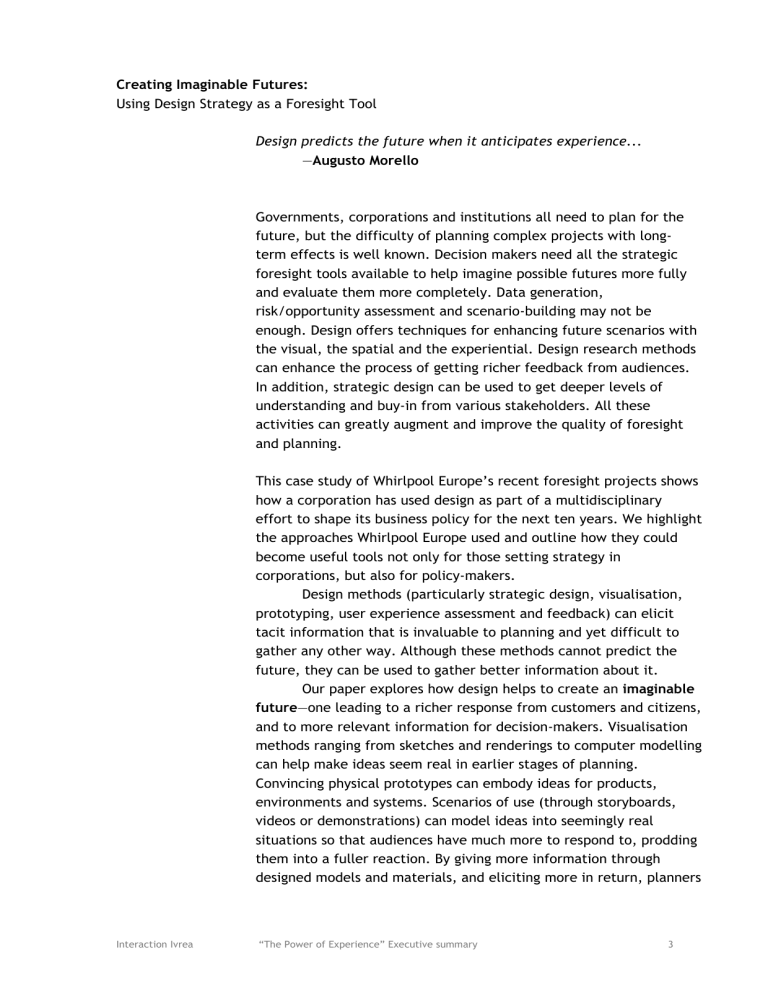
Creating Imaginable Futures:
Using Design Strategy as a Foresight Tool
Design predicts the future when it anticipates experience...
—Augusto Morello
Governments, corporations and institutions all need to plan for the future, but the difficulty of planning complex projects with longterm effects is well known. Decision makers need all the strategic foresight tools available to help imagine possible futures more fully and evaluate them more completely. Data generation, risk/opportunity assessment and scenario-building may not be enough. Design offers techniques for enhancing future scenarios with the visual, the spatial and the experiential. Design research methods can enhance the process of getting richer feedback from audiences.
In addition, strategic design can be used to get deeper levels of understanding and buy-in from various stakeholders. All these activities can greatly augment and improve the quality of foresight and planning.
This case study of Whirlpool Europe’s recent foresight projects shows how a corporation has used design as part of a multidisciplinary effort to shape its business policy for the next ten years. We highlight the approaches Whirlpool Europe used and outline how they could become useful tools not only for those setting strategy in corporations, but also for policy-makers.
Design methods (particularly strategic design, visualisation, prototyping, user experience assessment and feedback) can elicit tacit information that is invaluable to planning and yet difficult to gather any other way. Although these methods cannot predict the future, they can be used to gather better information about it.
Our paper explores how design helps to create an imaginable
future—one leading to a richer response from customers and citizens, and to more relevant information for decision-makers. Visualisation methods ranging from sketches and renderings to computer modelling can help make ideas seem real in earlier stages of planning.
Convincing physical prototypes can embody ideas for products, environments and systems. Scenarios of use (through storyboards, videos or demonstrations) can model ideas into seemingly real situations so that audiences have much more to respond to, prodding them into a fuller reaction. By giving more information through designed models and materials, and eliciting more in return, planners
Interaction Ivrea “The Power of Experience” Executive summary 3
can gather information, gain insights and affect the direction of projects much earlier in the process.
The case study focuses on Project F: fabric care futures, an advanced design research initiative by the Global Consumer Design
(GCD) group of Whirlpool Europe (Cassinetta, Italy), led by design manager Richard Eisermann. This project explored what the future of fabric care could be in the next ten years and how this might affect the manufacturing of major domestic appliances.
Whirlpool used a combination of broad-based traditional market research, trends analysis and qualitative research to inform their strategic design process. Qualitative design research doesn’t simply ask what consumers want; rather, it observes their preferences and actual usage. It employs techniques from anthropology and ethnography to gain insight about the actual behaviour of people. For Project F, the Whirlpool Europe Usability laboratory organised a qualitative in-home study in three EU countries, observing people during their typical laundry activities, to better understand their needs within the whole laundry process.
This approach also allowed them to rethink the design of clothing care in general, not just people’s interaction with washing machines.
An external consultancy, FutureConceptLab, Milan, conducted a parallel quantitative research study about the concept of domesticity in six European countries. Using a variety of techniques to reveal various facets of the user experience, the company reframed the entire problem of what to design in the future.
Four design teams (three external and one from Whirlpool) imagined and developed concept products, in order to provoke ideas, dialogue and future decision-making about what type of innovations to the laundry process would best fit customers’ needs and preferences in future years.
These were shown at key design exhibits and trade events in
Europe (such as HomeTech, Berlin; Salone del Mobile, Milan), which generated extensive press coverage for Whirlpool and enhanced the company’s reputation for innovation. The company will bring the prototypes back to the usability studio in 2003 to evaluate consumer preferences and inform the strategic planning for the Whirlpool
2004–05 product line.
By creating an innovation-friendly climate within the company, both Project F and the earlier Macrowave project
(envisioning how microwave technology could be used in products quite unlike those we see on the market now) created an even greater impact inside Whirlpool than without. The quality of the project ideas stimulated internal interest, buy-in and support, and
Interaction Ivrea “The Power of Experience” Executive summary 4
opened up a dialogue between all the stakeholders involved: designers, marketers, engineers and executive decision-makers. GCD gained a great deal of credibility from the projects, so much so that divisions within Whirlpool Europe now vie for its strategic foresight services. By demonstrating its ideas through tangible means and gaining outside recognition, GCD gained a voice in discussions about corporate strategy and contributed an entirely new perspective.
Design research cannot be effective unless its results are communicated and acted upon. GCD Whirlpool Europe partnered with the company’s communications department to position ‘design research as a cornerstone of exciting corporate communication opportunities’. The company is committed to a follow-up project in
2003, demonstrating its desire to continue innovation in the field of design. In focusing first on products (microwaves), then on processes
(like fabric care), next on products and processes in context
(people’s homes), Whirlpool Europe is positioning itself beyond the approach of the traditional appliance market. In creating imaginable futures, GCD is using the power of experience as a catalyst to shape visions of the company’s future.
How can the process of creating an imaginable future be enhanced and extended?
There are several ways: scenarios could be displayed alongside the prototypes to show more vividly how they can be used. Involving users in the design process (participatory design) could give the company more feedback, particularly if it employed user experience assessments at the various stages of the process, and could help translate design research into realisable solutions earlier in the design process. Finally, integrating GCD’s usability team into the evaluation of proposed user experiences could establish a feedback loop from imaginable futures into strategies the company could act upon.
The more important question, of course, is how can such foresight activities be useful to decision-makers and policy-makers in
other situations and organisations? The Whirlpool Europe case study points to methodologies from the design professions that can augment the range of strategic foresight tools already available to policy-makers. We believe these design methods and activities offer a qualitative enhancement to current ways of planning for the future.
Jan-Christoph Zoels, Silvia Gabrielli
Interaction Design Institute Ivrea
Interaction Ivrea “The Power of Experience” Executive summary 5


